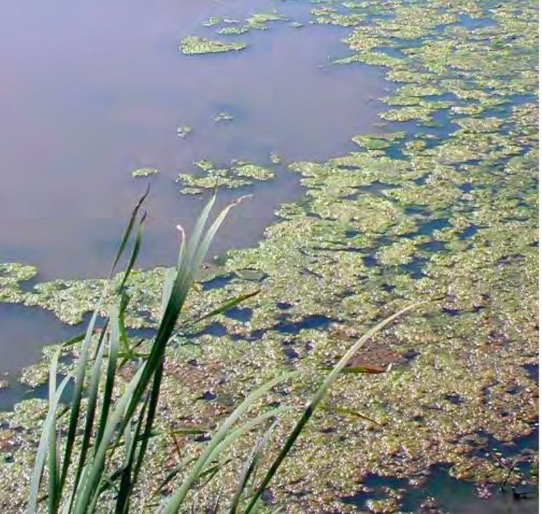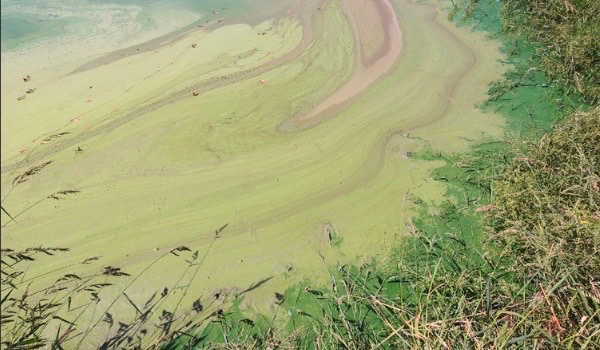Copper Sulfate Applications for Filamentous Algae
Filamentous algae are a common problem for pond owners. These stringy green algae begin growing in the spring on areas of the pond bottom and often develop into floating mats (Figure 1). Planktonic algal scums are not stringy and typically require different management steps than are discussed here. Southern naiad may be confused for filamentous algae, but naiad has stems and narrow, linear leaves.
Figure 1. Filamentous algal mats (top) can be picked up with a stick but phytoplankton algal scums (bottom) cannot. (Credit: University of Arkansas at Pine Bluff)
This factsheet is a general framework to assist in practical application situations. As with any pesticide use, work with your agriculture Extension educator to determine the management steps that might also correct underlying causal factors.
Herbicides are seldom a stand-alone solution. Copper sulfate and copper products provide only short-term control and algae are prone to grow back quickly. These limitations are discussed in NREM-9218, Copper Sulfate – An Often Overused Chemical in Pond Management.
Applying herbicides to aquatic sites can be different than terrestrial applications. For this reason, you need an overview of how to use aquatic herbicides. Read L-455, Aquatic Herbicides: Essential Information for New Applicators.
Important Guidelines for Applying Copper Sulfate:
- Windless days are best. When water is moving, treating small areas or even a large portion of a pond may be ineffective due to dilution.
- Colder water temperatures make for less effective treatments. Applications to water that is below 60Fo are unlikely to be effective. Winter applications are seldom done.
- Do not use copper sulfate or copper-based herbicides around sheep or goats.
- Avoid trapping fish in dangerous “hot spots”. Make your applications in strips starting along the shoreline and working successively outwards. Always allow an escape path for the fish.
- Avoid breathing the dust when handling, mixing or applying copper sulfate. Follow all safety recommendations included in the product label.
- If the steps outlined below for calculating treatment amounts are too difficult, consider using a chelated copper product instead. Although more expensive, calculating the amount needed is often simpler using the tables in the product label. Refer to labels for Cutrine, Komeen, K-Tea or other products.
Scenario 1: A Narrow Strip of Filamentous Algae Along a Shoreline
In this situation only a very small area and very small portion of the pond will be treated, so the risk of an over-application is low.
In a plastic container dissolve one teaspoon of copper sulfate dissolved in a gallon or so of water. This will treat a 300 square foot area with an average depth of 1 foot. For example, a 600 square foot area that is 2 feet deep on average will require 4 teaspoon of copper sulfate.
This treatment scenario is complicated by diffusion and water movement between the treatment target area and the rest of the pond. Higher application rates may be appropriate, but it is important never to exceed the limits discussed in Scenario 3.
Never use a metal container when mixing or working with copper sulfate. Screen the dissolved copper sulfate through a window screen as you pour it into a sprayer. This is necessary to remove grit particles that would otherwise clog your spray equipment.
Scenario 2: A Broader Band of Algae
If the percentage of the pond being treated is small, the risk will remain small.
Dissolve copper sulfate in a plastic bucket in the same manner as in Scenario 1. One teaspoon of copper sulfate will treat a 300 square foot area that has an average depth of 1 foot.
After dissolving the crystals, application might be made by using a cup to sling the dissolved copper sulfate while providing as even coverage as possible. Application though a sprayer as discussed in Scenario 1 is another option.
Scenario 3: Algae Covering a Large Portion of the Pond
The greatest risk in any pond herbicide application is killing too large an amount of plant material. As the dead material decays, scarce dissolved oxygen is used up, potentially causing fish to suffocate.
Minimize the risk of a low oxygen fish kill by following these steps:
- Select an area for treatment that is no more than ¼ of the total pond surface area. Note that Google Earth, using the Chrome browser, is one way to measure pond surface area. Click on the measure icon on the left.
- Determine the water’s total alkalinity level by doing an OSU Irrigation Water Test. This is needed to calculate a safe and effective application rate.
- Determining the volume of water in the area to be treated in acre feet using these
steps:
-
Determine surface square feet of the area. Often this is a rectangle (Square footage = length x width in feet). For other shapes use Google earth as described above.
-
Divide the surface square feet by 43,560 to calculate the surface area in acres.
-
Determine the average depth (feet) of water in the treatment area by taking 20 depth readings with a weighted cord in random locations within the treatment area. Add all the depths and divide by 20 to get average depth in feet.
-
Multiply surface acres by average depth to determine the volume of the treatment area in acre feet.
-
Example:
Area to be treated is 100 feet long and 75 feet wide
100 feet x 75 feet = 7500 sq feet
7500 sq feet / 43,560 = 0.17 acres
Twenty depth readings (in feet) are taken in random locations in the area to be treated:
3.5 + 4.2 + 4.7 + 2.9 + 6.0 + 5.1 + 3.8 + 2.9 + 1.8 + 3.4 + 4.6 + 3.3 + 4.7 + 2.9 + 6.3 + 5.1 + 3.8 + 2.9 + 1.4 + 3.4
The sum of these twenty depths is 73.3 feet
73.3 feet / 20 = 3.7 feet average depth
3.7 feet x 0.17 acres = 0.6 acre feet
- Use Total Alkalinity (ppm) and Volume (acre-feet) to determine the pounds of copper sulfate needed for a safe and effective treatment of this area. Here is the formula:
Pounds of copper sulfate needed = acre feet x (total alkalinity in ppm / 100) x 2.72
-
- Ponds with a Total Alkalinity of less than 40ppm should not receive a copper sulfate treatment: risk a direct toxicity to fish is high. One option in this case is to raise Total Alkalinity by applying 1000+ pounds of fine mesh agricultural limestone per surface acre, waiting several weeks and retesting for Total Alkalinity. The lime must be as evenly applied across the pond bottom as practical. NEVER use quicklime, slaked lime or any form of limestone except agricultural limestone. Consider using a chelated copper product, e.g. Cutrine Plus, while waiting for alkalinity levels to rise, if you want faster control.
- Ponds with a Total Alkalinity of more than 200 ppm should not receive copper sulfate unless citric acid is also applied at the same
time. The citric acid is needed to ensure the copper ion stays in active form long
enough to be effective against algae.
-
- Pounds of citric acid needed = acre feet x 8.
- Pounds of citric acid needed = acre feet x 8.
-
Example (continued):
An OSU Irrigation Water Test shows a Total Alkalinity of 129 ppm
Because this is more than 40 ppm and less than 300 ppm there is no need for either liming or citric acid.
Pounds of copper sulfate needed = 0.6 acre feet x (129 ppm / 100) x 2.72 = 2.1 pounds.
Additional Guidance
- As you make the application, take care to not trap fish in “hot spots”. Always leave an escape route by treating the shoreline strip first and working sequentially outwards.
- Wait until the plant decay process is complete before treating the next section. Typically, this takes 2 to 3 weeks.
Alternative Application Methods
There are several additional ways copper sulfate might be applied.
- Spray boom or application “wand” using a spray rig mounted in a boat or on an ATV.
- Uniform application is possible.
- Expensive, if equipment must be purchased.
- As with any sprayer, screen the dissolved mix as it is added to the spray tank to exclude grit that would otherwise clog the sprayer.
- Injection below the surface via weighted trailing hoses
- This method can be beneficial if algae or target plants are well below the surface.
- Tote sack or fine mesh bag dragged behind boat
- Usually only done in large ponds
- To ensure even application, only a portion should be applied initially. Get a feel for the rate at which the copper sulfate crystals are dissolving, before using the entire amount.
- Broadcasting crystals
- This method is discouraged: Although expedient, copper sulfate crystals are often lost in the soft pond bottom before they can dissolve in the water column.


